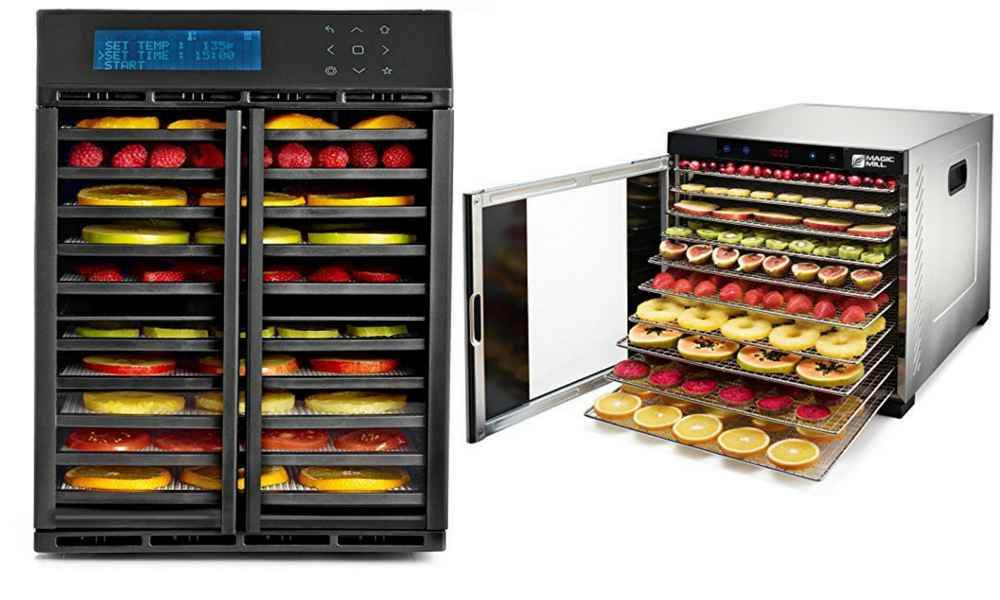Horizontal Flow Dehydrators: Buying Guide

Horizontal flow dehydrators are easily recognizable; they are shelf-like units that are either rectangular or square-shaped and usually consist of a unit “box” that contains the stacked trays. The heating fan is located in the back of the unit and disperses hot air evenly throughout the shelves. In most cases, this type of dehydrators also boast a more powerful fan, making it ideal for more demanding users. Some of the popular horizontal flow dehydrators on the market are the magnificent Excalibur RES10 or Magic Mill Food Dehydrator Machine.
Of course, there are other models available by these company’s but if you want large capacity and power packed performance, these two come highly recommended by users.
Pros and Cons of Horizontal Flow Dehydrators
Although they offer a much more impressive performance in comparison to the vertical flow food dehydrators, these units are not without their faults. Here we detail the benefits and downsides of horizontal dehydrators, so you can make a decision that you won’t regret later.
Pros
- Horizontal flow food dehydrators pack much more power than the basic vertical unit. Thereby, they are more suitable for drying tougher foods, such as meats. Further, most horizontal flow dehydrators have a temperature range that goes up to 160° F or 165° F. Therefore, they, more often than not, meet the USDA Meat and Poultry Hotline’s jerky making guidelines.
- Due to their heat dispersal system and its placement in the rear section, dehydrating food in these units takes less time than it would in a dehydrator that utilizes vertical air flow.
- These are much more suitable for professional use or large family as they have a greater capacity.
- In most horizontal flow dehydrator, the trays don’t have to be rotated and the food is always dried evenly. It is extremely rare that you will come across a model with this design that you can’t set and forget about, coming back to open the unit to perfect results.
Cons
- Shelf-like dehydrators are usually much more expensive than vertical flow units. Sure, the price range varies even in horizontal flow dehydrators, but if you’re looking for a quality machine, be ready to shell out a good amount. As a beginner who hasn’t yet fully experienced the benefits of food dehydration at home, you may find this as too big a downside to overlook. In this case, we’d recommend starting out with a stacking unit and upgrading to a horizontal flow dehydrator at a later stage.
- These dehydrators take up much more space in the kitchen than their vertical counterparts, and they are definitely not as easy to move around. If you’ve got a small kitchen or you travel frequently and portability is an important factor for you, these machines are not the right choice.
What to Look for in Horizontal Flow Dehydrators
While they might all look the same, their features are certainly not. Here are some basic things you need to look for when buying a horizontal flow dehydrator.
Materials
Manufacturers tend to make these units in either stainless steel or high-quality BPA-free plastic. In most cases, the flexibility of your budget will dictate the choice of the material. To be clear, stainless steel is the better option, but it also comes with a hefty price tag that not everyone is comfortable with.
Size and Capacity
In most cases, horizontal flow dehydrators offer impressive capacity for drying foods, but it will also impact the amount of space they occupy in your kitchen. Professional (commercial) food dehydrators can handle pounds and pounds of food, but your regular unit is more than enough for an average family’s needs. And it will fit in your cupboard or counter top to boot!
Bonus features
Do you want a digital thermostat, automatic shut-off feature, or nifty add-ons such as bonus fruit leather trays? Explore your options. You want the most value for money, but don’t go over your budget if you realistically don’t plan on using any of the additional features!
Conclusion
Horizontal flow dehydrators are a great option for those enthusiastic about eating a healthy diet, saving time, and saving money. Their large capacity is great for big families, people who have low patience and want to dehydrate in big batches, or anyone with a garden and ample harvest. Of course, that’s not to say that this design doesn’t have its own set of drawbacks. It definitely amps up the price tag for one. But if you can make peace with that, you’ll find its benefits far outweigh its downsides—of course that’s if your needs match with what’s on offer. So before you make any decision be sure to analyze the purpose of your purchase.
